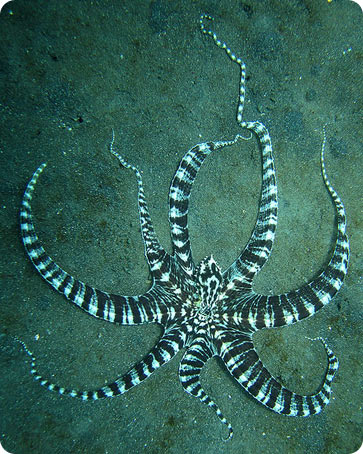If a species of octopus found off the coast of Indonesia had a good agent, it might get a lot of gigs on late-night talk shows. That’s because it’s one of the best mimics in nature -- it can imitate everything from a snake to a jellyfish. The imitations might not be good enough to win any acting awards, but they are good enough to keep the octopus safe from predators.
 Mimic octopuses immitate other organisms. Credit:Steve Childs/Wikipedia
Mimic octopuses immitate other organisms. Credit:Steve Childs/Wikipedia The mimic octopus was discovered in 1998. It spans a couple of feet from armtip to armtip, and it lives in shallow, muddy waters off the mouths of rivers.
Like other octopuses, the mimic can change color to blend in to the background. But the mimic takes the “blending-in” business a step farther: it can make itself look like a variety of other marine organisms, most of which are toxic.
When it’s jetting across the ocean floor, for example, it may sweep back its arms to form a streamlined shape that resembles a poisonous type of sole. At other times, it spreads out its arms and stretches web-like structures on their sides to resemble the poisonous spines of a lion fish. And at still other times, it sticks six of its arms into burrows and extends the other two to resemble a venomous sea snake. The octopus may also imitate jellyfish and other creatures.
Even better, it appears to know which disguise is best for scaring off specific predators. And it doesn’t repeat a given disguise very often, so it avoids inspection by the creatures it’s imitating. That helps keep the mimic octopus safe in the fish-eat-fish world at the bottom of the sea.

